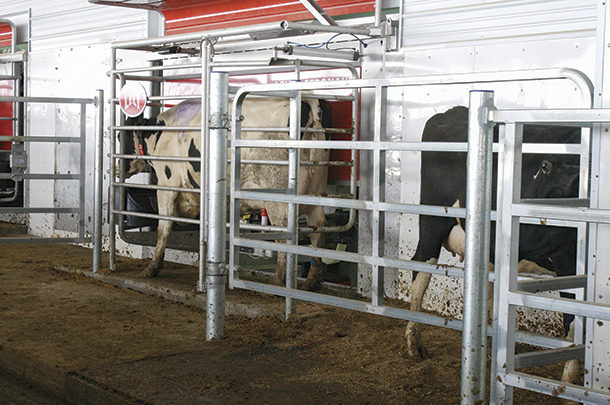There is a saying in the information technology industry: If you need to perform a task more than twice, you should automate it. Dairy producers who have adopted automated milking systems have taken this to heart.
The daily milking process is easily the most repetitive task that takes place on a farm every day. So it may not come as much of a surprise that we have continually tried to make the process much more automated. We have evolved from flat barns and stanchion barns with buckets and pipelines to herringbones, parallel parlors and rotaries.
For more than the past two decades, robotic milking systems have taken automation to another level. With automated milking systems, the intent is to minimize the effort needed to milk the cow. Of course, there are still heifers that need to be trained, and those cows that simply do not take to the robot, but the idea is to get people out of the physical labor of milking and be able to devote more time to management.
New ways of analyzing familiar data
When herd owners make the change to robots, reports generated out of those systems look quite different than the ones they were previously accustomed to. While non-robot herds may look at traditional DHI herd summaries or monitoring reports, on a daily basis robot herd managers are regularly looking at a dashboard of key performance indicators (KPIs) that not only include average milk per cow and times milked each day but also novel KPIs such as box time per visit and the amount of milk that is separated because of treated cows, to name a few.
All producers are interested in average milk per day. It does not matter what barn you are in; the milk check is still the primary revenue source for most dairy producers. Contrast the producers with milking parlors who typically know their average milkings per day (either 2X or 3X), while robot herds vary by the cow. High-producing cows may visit the box as many as four or five times per day while tail-enders may need to get milked only twice. Adhering to a similar schedule, especially in a smaller non-robot herd, may be particularly challenging.
Pounds of milk per robot is a key benchmarking metric. The goal is to get the most milk in a day with the fewest number of cows to maximize return on investment; factored into that equation are nutrition, milking speed and the right balance between enough and not too many cows. Most farms find the sweet spot between 55 and 65 cows per robot, depending on the model.
Milking speed is a key factor to optimize the amount of milk flowing through a robotic system. While cows can milk out too fast, often cows milk too slow, which means they are occupying the box when others should be in there. One particularly insightful metric is the attach time per quarter. In one case that got my attention, the cow’s front two quarters were finished in five minutes while the remaining hind quarters took 10 minutes to finally milk out. In how many barns would that attach time be 10 minutes for all four quarters?
Analysis of milk components and quality
Robotic systems can provide indications of fat and protein, milk urea nitrogen (MUN), conductivity and beta-hydroxybutyrate (BHB) levels in the milk. Fat and protein are obviously important when it comes to payment, but the inversion of those readings (when the protein percent exceeds the butterfat content) is an early indicator of acidosis. Monitoring BHB levels allows the producer to pick up ketosis before the cow is showing symptoms. MUN levels are more a matter of fine-tuning rations than anything else.
Conductivity is another important feature. Even though conductivity is not a straight-line relationship with somatic cell count (SCC), increases in conductivity are an indication that something is happening with the cow and should garner the attention of the herd manager. Detailed quarter milk yield and conductivity of each quarter is additional information.
New and novel data
Along with all the metrics that most farms look at on a regular basis, these automated systems often provide a lot of data useful for herd management that is not directly related to amount of milk produced. KPIs related to reproduction can be more cumbersome than producers are used to seeing (Table 1).

For example, calving intervals may be reported in days, when months are the more common way it is reported. Breakouts by lactation group may or may not exist. Often, the robot software will display trends – but usually does not present data in a concise report that producers are familiar with.
Of course, robotic herds can continue to process their records through the DHI system and receive the standard reports they are used to seeing to supplement their robot metrics. For those who have chosen to stop participating in DHI services, another option to continue to receive those reports is a program introduced by Holstein Association USA and AgriTech Analytics two years ago called TriStar AMR (Automated Milk Records).
This program processes the data directly from the robotic systems, and herd records are computed like any other DHI herd. Because there is no DHI technician or lab fees, this program greatly reduces the cost of the records. Individual lactation records qualify for inclusion on Official Holstein Pedigrees (designated as AMR records), and producers receive the DHI reports at a considerably lower cost.
I will share a couple of examples of how TriStar AMR has helped producers supplement the data generated by their robotic software with information available through our standardized reports to improve their herd management. In one conversation I was having with a dairyman, he shared that ranking his animals by Relative Value and fat-corrected milk was an important benchmark he was unable to get from his software.
While the system in question provided a fat and protein indication, it did not provide 305-day Mature Equivalent milk and fat values, which is the basis of Relative Value calculations. By having access to traditional, standardized reports through TriStar AMR, the producer was able to access valuable information they had been missing.
In another instance, a TriStar AMR producer shared how their bankers appreciate the consistency of the DHI summaries and reports. The basis for all those numbers is the robotic data; turning that data into useful information the banker is used to seeing has long been the strength of the DHI reports.
Automated milking systems provide information to better manage the reproduction and health of a dairy herd while improving milk production. Producers who adopt the automated milking systems technology have many additional tools to make unbiased decisions. The challenge is to optimize the use of that data in ways that ultimately improve the profitability of their businesses.












